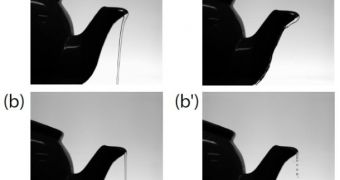For people serving tea on a regular basis, the teapot effect is well known. It appears when the liquid dribbles at low flow rates, causing numerous tea stains on table covers and clothes. Now, experts in France have managed to determine the root cause of this peculiar effect and also to come up with a way of addressing it. The investigators say that they have discovered a way of linking the small world of hydrophobic materials and effects to the large world of fluid dynamics, where inertia is king.
When you pour tea from a kettle, it first begins to flow rapidly, and then, as the pressure drops, so does the flow rate. As this happens, the liquid starts taking the shape of the kettle, and then flowing on the sides of the container. The team of experts, led by scientists at the University of Lyon Laboratoire PMCN, and the Ecole Polytechnique LadHyX, has determined that, by coating the spout of the teapot with a super-hydrophobic coating, such as, for instance, with black soot, the liquid flow stops dribbling and running along the sides of the kettle.
“Over the recent years, the development of super-hydrophobic materials, exhibiting the so-called Lotus effect, has stirred up the physics of surfaces. Their exceptional water repellency results from the combination of bare hydrophobicity and micro- or nano- structures decorating the solid surface. These materials have triggered research, leading to the discovery of unforeseen phenomena, like bouncing drops, or big splashes of impacting bodies, the exploration of which is still in its infancy,” the scientists say in a new paper detailing the finds. The work appears online in a recent issue of the journal arXiv.
In an interesting turn of events, the old trick housewives used to stop dribbling, namely the addition of butter to the spout of the kettle, seems to have been founded on good science. The butter acted like the hydrophobic material, preventing the water, or tea, from clinging on to the surface of the teapot, and then flowing on its sides. The new investigation may also favor a number of uses in fluid mechanics, and especially in microfluidic devices, considering that super-hydrophobic materials can be controlled electronically.

 14 DAY TRIAL //
14 DAY TRIAL //